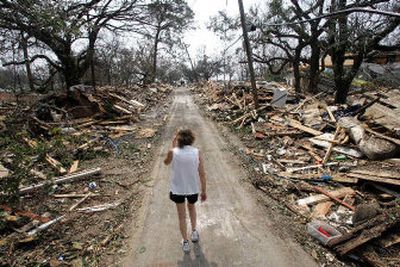Some hurricane victims offered mortgage relief

WASHINGTON – The Federal Housing Administration is launching a program to pay the mortgages of up to 20,000 victims of hurricanes Katrina, Rita and Wilma for as much as a year.
The unprecedented mortgage relief will be offered to people who own homes with FHA-insured mortgages in designated hurricane-ravaged parts of Alabama, Florida, Louisiana, Mississippi and Texas.
“These families have been devastated. Not only are they living far from home right now, but many have lost their source of income,” Housing and Urban Development Secretary Alphonso Jackson said in remarks prepared for delivery when the program is announced Monday.
“We want to help end that hopeless feeling for them, by letting them come back home and concentrate on putting their lives in order without having to worry about making mortgage payments,” Jackson said.
The program is the latest of several steps by the department and its housing administration to address the mortgage woes of hurricane victims. On Nov. 23, Jackson extended a moratorium by three additional months, until Feb. 28, on foreclosures against FHA-insured families damaged by Katrina or Rita. A freeze on foreclosures on FHA-insured Wilma victims lasts until Jan. 22.
In contrast to the plan for federally insured mortgages, much of the private mortgage industry in September voluntarily granted a three-month freeze on foreclosures on mortgages without federal insurance. But that grace period is ending. Many of these mortgage-holders are being asked to resume payments – even back ones – this month.
The FHA’s plan could cost as much as $200 million if all the estimated 20,000 eligible homeowners apply, federal officials say. But none of that total would be taxpayer funds. The money would come from FHA insurance reserves funded by premiums paid by borrowers who have FHA-insured mortgages, the officials say.
Ultimately, the homeowners would have to repay the FHA, but under very generous terms. The federal mortgage payments would be interest-free loans not due until the homeowner’s original FHA-insured mortgage was paid off.
To obtain the mortgage assistance, the homeowners would have to sign a subordinate, interest-free mortgage payable to the FHA for the amount of assistance, which would cover principal, interest, taxes and insurance for up to 12 months.
Participants would have to be committed to staying in these homes and either able to live in them now or have the money from insurance payments or elsewhere to repair or rebuild the homes within 12 months. In this way, Jackson said, the program “is also an investment in the long-term stability of their neighborhoods.”
Kurt Pfotenhauer, senior vice president of the Mortgage Bankers Association, said the amount of financial aid offered “will help many borrowers get their lives back on track and allow them to focus on the formidable task of rebuilding.”